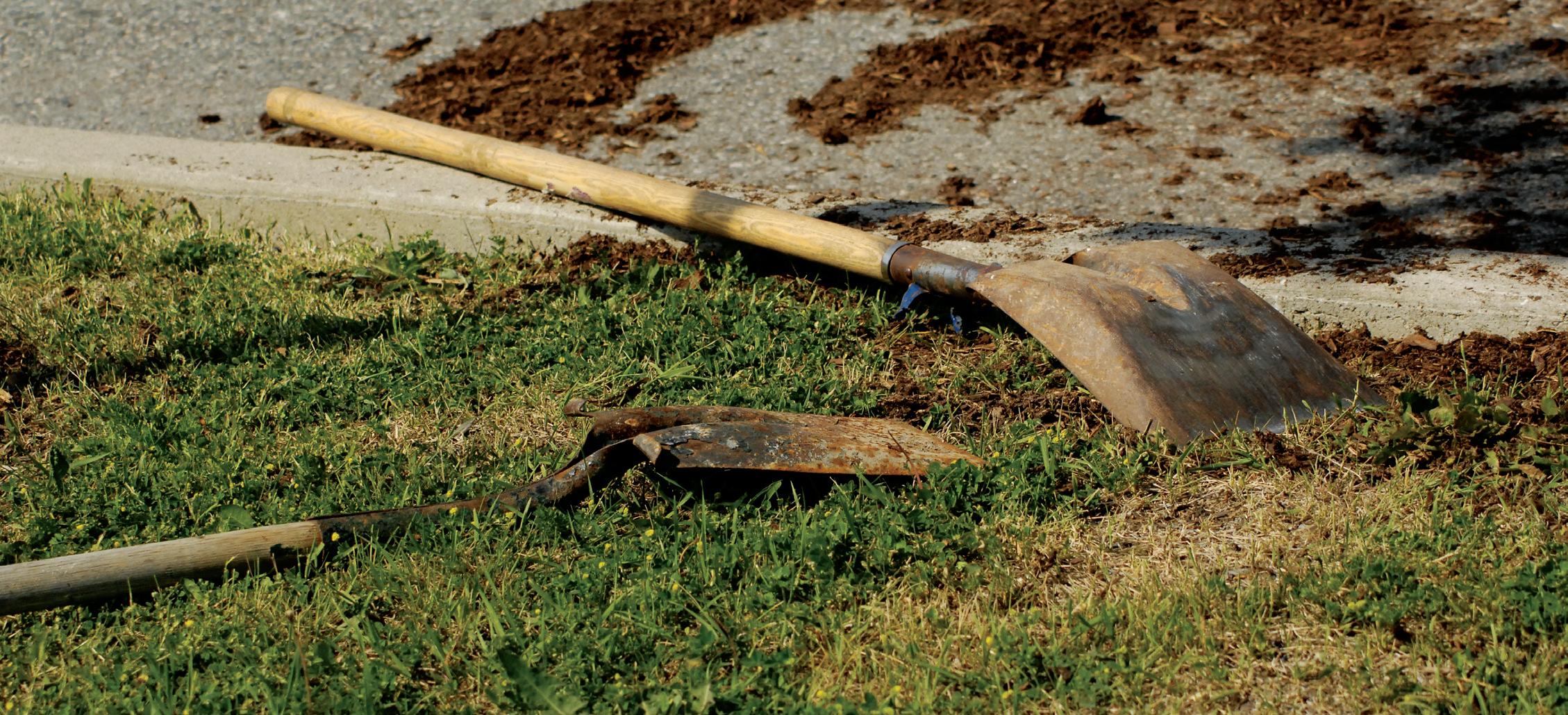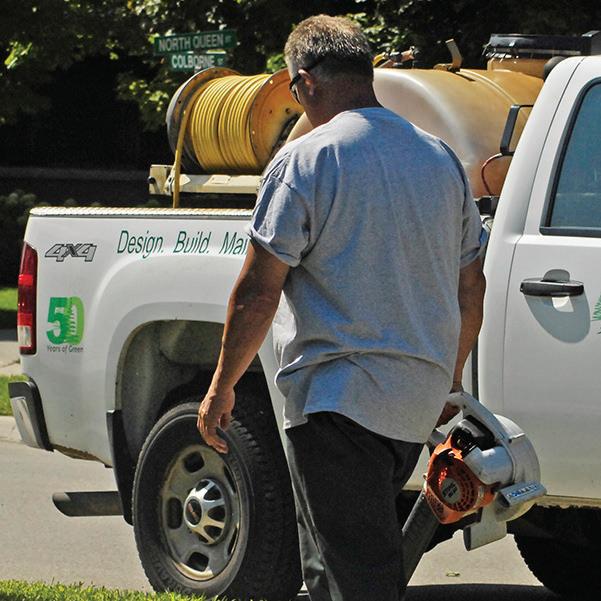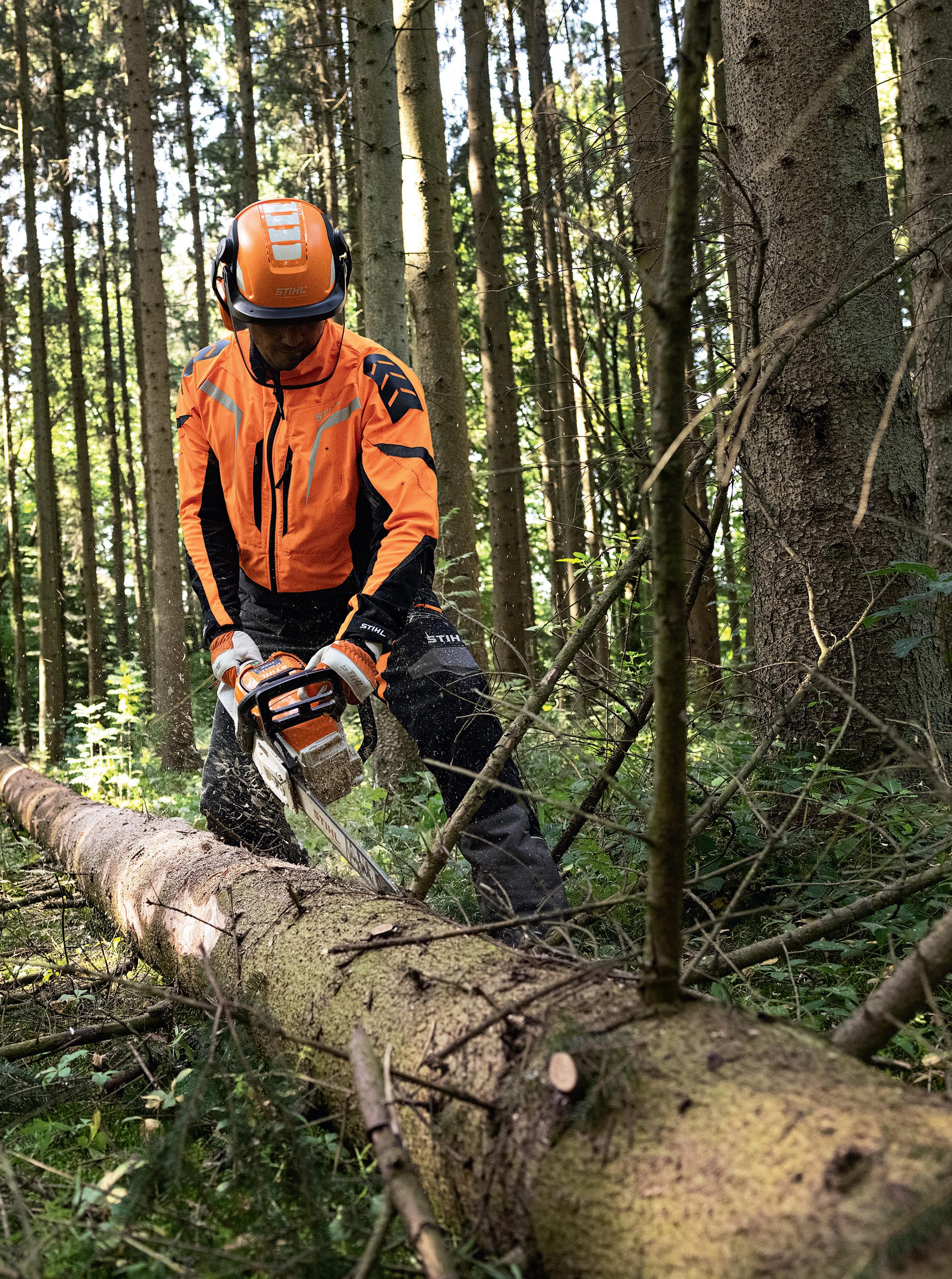










President Anthony O’Neill - NL
Past President Phil Paxton, CLHT, CLHM - AB
First Vice President & Communications Chair Bill Hardy, CLHM - BC
Second Vice President Anita Heuver - AB
Treasurer & Climate Change and Adaptation Chair Alan White - ON

BCLNA Michael Kato - BC
Landscape AB Jeff Oudyk - AB
Landscape SK Aaron Krahn - SK MBNLA Guy Dowhy, RSE, CLHT, CLHM - MB

Landscape ON Dave Wright, CLD, CLHM- ON Landscape NS David Thompson - NS Garden Centres Canada

Chair Robin Godfrey - NS Landscape NB/PEI & Member Services Chair & Insurance Chair Kevin Nauss, CLHM - NB Landscape NL Peggy Head - NL
Landscape Canada Chair Peter Guinane - ON
Research Chair Vic Krahn, CLHT - SK Government Relations Chair Christene LeVatte - NS Professional Development Chair & Human Resources Chair Jeff Foley, CLHT, CLHM - BC Growers Canada Chair Jeff Olsen - ON
Executive Director Victor Santacruz, CLHM, CAE, victor@cnla-acpp.ca
Deputy Executive Director Rebecca Doutre, CLHM, CAE, rebecca@cnla-acpp.ca
Finance & Administration Cheryl Gall, CAE Manager cheryl@cnla-acpp.ca
Growers Sector Jamie Aalbers Specialist jamie@cnla-acpp.ca
Communities in Bloom Sonia Parrino Program Specialist bloom@cib-cef.com
Landscape & Retail Sector Anne Kadwell, CLHT Specialist anne@cnla-acpp.ca
Industry & Government Leslie Sison, CAE Relations Specialist leslie@cnla-acpp.ca
Communications Dave Mazur Specialist dave@cnla-acpp.ca
Communications Lauryn Mullan Coordinator lauryn@cnla-acpp.ca
Media Stuart Service Coordinator stuart@cnla-acpp.ca
Member Services Teagan Schroeder Specialist teagan@cnla-acpp.ca

Member Services Nicole Xavier Coordinator nicole@cnla-acpp.ca
Member Cathy Lam Services cathy@cnla-acpp.ca
Certification Edith Oyosoro Coordinator edith@cnla-acpp.ca
Environmental Frydda Sandoval Policy Coordinator frydda@cnla-acpp.ca
Minor Use Peter Isaacson B.Sc. MPM / IPM Coordinator peter@cnla-acpp.ca
COMMUNITIES ACROSS CANADA and around the world gathered in Victoria to celebrate the first, in-person Communities in Blooms National Symposium & Awards in three years.
The itinerary from October 21-23 was packed, with morning keynote speakers including garden writer Jeff DeJong, Victoria Mayor Lisa Helps and gardening expert Brian Minter. Attendees visited Hatley Castle for a self-guided tour of its themed gardens, and then visited the beautiful Abkhazi and Butchart Gardens.
The CiB community showcase took place on October 21 at Butchart Gardens’ The Blue Poppy restaurant, recognizing the achievements of national and international finalists.
The following day after the morning presentations, attendees went on a walking and ferry tour, learning about Victoria’s rich history and taking in spectacular views in the city and on the water.

The symposium weekend reached its crescendo in the evening of October 22 during its provincial, national and international awards ceremony at the beautiful Crystal Garden at the Victoria Conference Centre.

CiB National Chair Susan Ellis noted that the past two years have tested the strength and resolve of everyone in the room.
“Together, we have all persevered,” Ellis continued. “We have emerged this year, 2022, and have made new and lasting contributions in celebrating the places in which we live, work, play, and visit.”
The 2023 Communities in Bloom National Symposium Awards will take place at the Regional Municipality of Wood Buffalo, AB on September 27 to 30.






• BC Landscape & Nursery Association
• Landscape Alberta
• Landscape Saskatchewan
• Manitoba Nursery Landscape Association
• Landscape Ontario
• Coverage for one-life companies and up with no medical questionnaire required.
• Digital platform – easy to use, enhanced employer / employee experience
• Fully insured programs
• Reduced group benefit plan options
• Administration Services Only programs - ASO
• Health Care Spending Accounts - HCSA
• Collage HR and payroll management tech
• Out of province/Canada emergency medical/ travel insurance
• Trip cancellation insurance
• People advantage – Cost savings network
• Landscape New Brunswick
• Landscape Nova Scotia
• Landscape Prince Edward Island
• Landscape Newfoundland & Labrador
• Wellness programs
• Access to Self Help Works- Online lifestyle management

• Life and Dependent Life Insurance
• Accidental Death and Dismemberment Insurance
• Health, Drug, Dental, and Vision Coverage
• Short Term and Long Term Disability Insurance
• Critical Illness Insurance
• Coverage for seasonal workers
• Foreign worker’s health insurance
•
• Errors and omissions coverage for landscape design professionals
• Rented equipment and rental reimbursement coverage
• Automatic coverage for Contractors Equipment acquired throughout the policy year
• Coverage for greenhouses and nurseries and growing stock
• Landscapers including snow removal operations
• Commercial “blanket” fleet rating for five or more vehicles
• Hail coverage provided
• Overspray pollution liability


• Legal Expense Insurance available

• Auto coverage including Cars, Trucks, Trailers, Motorcycles, Snowmobiles, and Motorhomes
• Homeowners coverages including Tenants, Condominiums, Rental Properties, Seasonal Residences, and Watercraft
• Convenient monthly payment plans with no service fees (except in Quebec)
• Access to quotes from multiple insurers
• A broad selection of coverages
• Assistance in determining the options that best meet your specific needs
• Claims advocacy should the need ever arise
• 24- hour emergency claims services
Information in this brochure represents a synopsis of coverage and is provided as a reference only. The actual policy, including endorsements determines coverage. It contains exclusions, limitations and other provisions not referenced (or only briefly summarized) here and the policy should be consulted for full coverage terms, conditions and requirements. Deductibles may apply. For exact terms, definitions, limitations, and exclusions, please speak with your licensed Marsh Canada Limited insurance broker, or refer to the policy wording.
This document is not intended to be taken as advice regarding any individual situation and should not be relied upon as such. The information contained herein is based on sources we believe reliable, but we make no representation or warranty as to its accuracy. Marsh shall have no obligation to update this publication and shall have no liability to you or any other party arising out of this publication or any matter contained herein. Marsh makes no representation or warranty concerning the application of policy wordings or the financial condition or solvency of insurers or
re-insurers. Marsh makes no assurances regarding the availability, cost, or terms of insurance coverage.
The home and automobile insurance program is underwritten by Intact Insurance Company of Canada in all provinces and territories except Saskatchewan or where government automobile plans exist.
Group Life, Health, and Short Term Disability Insurance underwritten by Manulife Financial; Accidental Death & Dismemberment (AD&D) Insurance and Critical Illness Insurance underwritten by Chubb Insurance and the Long-Term Disability Insurance underwritten by Fenchurch General.
Home and Automobile Insurance Programs underwritten by Novex Insurance Company in all provinces and territories excluding Quebec. Underwritten by Intact Insurance Company in Quebec.

ALTHOUGH INFLATION has declined since it peaked at 8.1% in June — a 30-year high — Canadian companies of all sizes continue to feel its repercussions, especially small businesses that may be trying to recover from COVID-19’s adverse effects on their operations. According to research by the Canadian Federation of Independent Business, 62% of small businesses still hold pandemic debt. Combining that with supply chain challenges, high energy costs, labour shortages, and interest rate hikes, doing business in Canada is becoming more and more costly. Small businesses may be looking for places to cut costs, including potentially reducing or forgoing small business insur-
ance. However, this could be a mistake, for a number of reasons. For example, as the frequency of extreme weather events rises, so does the likelihood of property damage. Inadequate insurance coverage can make it difficult for a small business to reopen after a major loss. With this in mind, business owners should ask themselves the following questions: How does inflation affect our existing insurance coverage? Could we afford to rebuild following a catastrophic loss? Are our current limits adequate?
According to Statistics Canada, 60% of businesses expect rising inflation to
continue to be an obstacle in the fourth quarter of 2022, due to surging material, fuel, and labour costs. Nearly 8 in 10 small business owners reported raising their prices more since mid-2021 than they would have in a pre-pandemic year. Unfortunately, with the cost of living also increasing due to inflation, consumers have less money to spend, resulting in generally lower sales for small businesses. The replacement costs for commercial property losses across the country have also increased substantially. Statistics Canada expects capital expenditures on non-residential construction, machinery, and equipment to rise 8.6% in 2022, due in part to increasing material and labor costs.
Additionally, supply chain challenges; increased focus on meeting environmental, social, and governance (ESG) targets; and a skilled labor shortage are causing significant increases in the cost of construction. Inflation impacts replacement costs not only for physical structures, but also for a variety of other items, including specialized tools and equipment, inventory, and computers.
The transitioning market presents small business owners with an opportunity to review insured values, policy limits and sub-limits, and other elements in the insurance contract to assess how their policies might respond to significant increases in costs to rebuild and restart operations, as well as any lost business income caused by an incident. Small business owners will also want to review their liability coverage to gauge how it would respond to any potential third-party lawsuits. To better protect your business from the impacts of inflation, it is wise to consider the following actions ahead of your next renewal:
l Verify that your coverage reflects the correct valuation
As construction costs continue to rise, small business owners should determine whether their insurance coverage adequately accounts for their full replacement costs and make necessary adjustments to help recovery following a catastrophic event. Be sure to consider your entire array of property types.
Insurers expect insureds to report accurate replacement values and business interruption figures, in line with valuation conditions established at the start of the policy term. To encourage this behavior, many policies include a co-insurance clause requiring policyholders to carry a limit of insurance equivalent to at least a specified minimum percentage of the value of their property. Sadly, insureds may unintentionally provide incorrect data based on market valuations, construction values, and/or outdated information. This practice can lead to insureds inadvertently being underinsured and having to pay for the replacement costs not covered by their claim.


Help ensure your valuation is accurate by engaging an external team of specialists to provide property valuation and risk assessment services. To best mitigate the impact of inflation, it is crucial for you to review the declared value of your assets and exposures during the policy period and not only prior to renewal. Any updates should then be clearly articulated to your broker.
l Develop a business continuity plan
A business continuity plan is an integral part of a company’s overall risk management and preparedness strategy. This framework should delineate all critical business processes and resources and outline their continuity strategies. Pay particular attention to preparing for potential property, liability, and business income losses. Working with risk consultants may help you evaluate the real world feasibility of your plan.
l Review your limits & coverages
Regardless of market conditions, reviewing your limits annually and making sure you have the right coverages in place will benefit your business. Do your policies adequately respond to the scenarios described in your business continuity plan? Do they offer any guards against future inflation? Your insurance broker can assess your current policies and help answer your questions.
In these trying times, it may be tempting to save money in the short term by reducing or removing insurance coverage. However, the costs associated with inflationary risk may outweigh any savings you might garner from decreasing your business protection. Help ensure your business is ready and able to bounce back from a loss by confirming your insurance provides the optimal protection for your business.
started today at www.hortprotect.com
”..supply chain challenges, high energy costs, labour shortages, and interest rate hikes, doing business in Canada is becoming more and more costly.”
 BY LESLIE SISON, CAE
BY LESLIE SISON, CAE
ON SEPT 1, 2022, IMMIGRATION MINISTER Sean Fraser made an announcement that a new online service has been introduced to help improve the client experience and to tackle the existing backlog. In addition to the new process, Fraser has announced that permanent and temporary residence applicants who are already in Canada, and meet certain criteria, will be exempt from the medical exam requirement. The media release did not state what that criteria is or when this will take place, but the IRCC expects it will affect 180,000 newcomers.
As of Sept 23, 2022, Immigration, Refugee and Citizenship Canada (IRCC) will begin transitioning to 100% digital applications. Alternative formats will still be available upon request for
those who require accommodations. By Sept 2023, seven more permanent and temporary residence programs will have an application tracker like the one launched in February for spousal, partner and dependent child sponsorship applicants. There is also an improvement to the citizenship application that will include access to representatives. This fall, IRCC will now also publish estimates on how long it will take to process an application.
Full Report: Strategy to Expand Transitions to Permanent Residency - PDF Version (PDF, 2 MB)
A motion was called in May 2022 for the government to release a plan to expand economic immigration pathways for greater transitions from temporary resident status to permanent residence status for workers at all skill levels. This will address the Temporary Foreign workers and International Students, both of which will help address the immediate workforce needs of different employers, provide a wide range of skill levels and education backgrounds as well as support business growth and development.
The goal of the government is to strengthen the connection between the labour markets and the immigration programs and to capture skills needed across many sectors including health, hospitality, transportation, trades and more. The focus in on helping individuals transition from temporary to permanent residency by expanding/adjusting the existing pathways.
The government will use 5 pillars to achieve this:
Pillar 1
l
Increased immigration levels to provide larger, permanent labour supplies
l Increases opportunities for more temporary workers to transfer to Permanent Residency
Pillar 2
l
Aims to reform the Express Entry System through increased flexibility in immigration selection tools
l Will allow Minister to respond to labour market needs and regional economic priorities
l Department will review the Comprehensive Ranking System criteria – particularly points awarded for Canadian work experience/education, language proficiency and job offer.
l This will allow for more opportunities for workers at all skill levels

l Will make improvements to permanent economic immigration pathways to help the transition, including…
l New NOC classification which expands eligibility to certain occupations
l Improving newcomers access to information to ensure they meet necessary qualifications, connects them to federal and provincial/territorial programming
l Exploring better ways to transition essential workers (such as removing barrier for physicians)
l Introducing improved pilot programs to support transitions to permanent residence for those working in home caregiving occupations as well as the agri-food sector
l Supports communities in attracting and retaining newcomers, including through Francophone immigration
l The government supports Francophone communities outside for Quebec through measures aimed at meeting 44% French-speaking immigration target by 2023
l Municipal Nominee Program is being developed for municipalities to attract newcomers to address local labour needs.
l Provincial Nominee Program will continue to receive support to allow provinces/territories the flexibility to adapt and evolve their immigration streams to meet their individual market needs.
l Increasing processing capacity


l Improving Client Experience
l Modernizing the immigration system through technological improvements
l These initiatives are focused on ensuring newcomers are processed towards permanent Canadian status as quickly as possible.

International Students who have off-campus work authorization on their study permit, will now be allowed to work over 20 hours per week off-campus while classes are in session. The previous cap only allowed up to 20 hours per week to ensure the focus of students remained on their studies. This change will be allowed form November 15, 2022, until December 31, 2023. This will also be extended to foreign nationals who have submitted a Study Permit application and are approved by Immigration, Refugees and Citizenship Canada (IRCC).
This measure was announced my Minister Fraser October 7, 2022, in an effort to alleviate the labour shortages that are
being felt across Canada. Over 500.000 eligible international students already in Canada may be able to participate.
Canada continues to be a place where many international students come to study based on various factors, and the work and permanent residence opportunities the country offers is high among them. Over 452,000 study permit applications were processed between Jan and August of 2022, a 23% increase over 2021. “Statistics Canada research shows that international students who go on to gain permanent residence tend to integrate quickly into the Canadian labour market due to factors such as their Canadian work and study experience, as well as English and/or French language proficiency. This explains why Immigration, Refugees and Citizenship Canada (IRCC) offers a host of measures aimed at helping international graduates work in Canada and remain here.” ( (El-Assal, 2022) International Students have been a key source of permanent residents in recent years.
For more information, contact Leslie Sison CAE, CNLA Industry Human Resources & Government Relations, email: leslie@cnla-acpp.ca https://cnla.ca


AS WE START TO SEE THE LIGHT at the end of the tunnel of the COVID-19 Pandemic, we are faced with new views on work and, more importantly, a changing acceptance of work-life balance standards. Gone is the belief that once the pandemic ends that life will just go back to normal. How people viewed life before March 2020 is a thing of the past. COVID changed us, and for many there is no going back. While COVID took so much from us, it also gave to us. It gave us time at home, time with family, and a new way to work and live. It caused many to realize the rat-race is a race they no longer wanted to run. From this, two new terms are in the media that many employers are now struggling to understand and adapt to.
The Great Resignation shouldn’t be too much of a surprise. We have long known, especially in our industry, that the average worker was getting older, and that retirement was on the horizon. This,
we knew, was going to be a very big issue for our industry. The older generation was looking to step down, and the challenge we knew we would face came quickly. We knew there would not be enough new people to take over those roles. We also thought we had a few years to figure it all out. What we couldn’t have known was the pandemic was going to accelerate this timeline. During COVID, many who were near retirement age decided, for various reasons, to take early retirement.
Many were forced to retire, had to close shop, or found navigating the pandemic too challenging. Others decided life was too short and wanted to start enjoying retirement right away. Whatever the reason, this began The Great Resignation. According to the Institute for Economic Equity, in 2021 there were 3.3 million more retirees than in January 2020. This accounted for a 7% increase in retirement for people 55 or older.
It is interesting to note that this is not only reserved for the older generation. Many adults walked away from careers and jobs which weren’t providing them satisfaction. With the discovery that many jobs can be done remotely, many left places of employment that weren’t willing to adapt. Some wanted to take a few years to travel, go back to school, change their career paths and lifestyles. The result is an accelerated labour shortage we thought we’d have another 10-15 years to find solutions for.
Then there is the population that physically stayed in jobs but mentally they are not as dedicated as they once were. These are the individuals that are Quietly Quitting.
Quietly Quitting is the other buzz phrase in the media. This one is not as simple as The Great Resignation and there is a bit of controversy around what this one actually means. Some view Quietly Quitting as
an act of no longer accepting to work long hours, pushing themselves harder and harder just to remain “average,” to keep up with everyone else and not be recognized for going above and beyond, simply because that is what is expected. Some consider Quietly Quitting as just doing the bare minimum to keep their jobs. Only doing the work that is laid out in their job description. Nothing more and nothing less.
Even the definition is hard to determine. According to Wikipedia, Quiet Quitting is defined as, “an application of workto-rule, in which employees work within defined work hours and engage in work-related activities solely within those hours. Despite the name, the philosophy of quiet quitting is not connected to quitting a job outright, but rather doing precisely what the job requires.” While the Urban Dictionary defines it as, “when physically, you still turn up to work but mentally, you check out and do the absolute bare minimum to get by.”
While there isn’t a hard and fast definition of Quietly (or Quiet) Quitting, we do know that it stemmed from the pandemic. Many people had time to reflect on how they live and work and decided what they were willing to do to maintain a work-life balance. It is also seen as a response to burnout and stress and a way for workers to reclaim their lives. Whatever it is, it means that what some deem as “normal” work behaviour is changing. It may also signal that an employee is unhappy of dealing with more than they can handle, and you may be at risk of losing an employee.
With labour shortages being what they are, this is a risky situation to be in. Employers must be aware of who their workers are, how they feel about their job, and the environments that

they create. A work culture is often a make-or-break situation for many employees. Rest assured, there is a way to improve things, meet your employees’ needs, and be a company that people want to work for and with. Blog. weekdone.com has a great article referencing the recruitment professional Mel Kleinman’s article “Top 10 Ways to Ensure Your Best People with Quit” (https:// blog.weekdone.com/stop-your-talentedemployees-from-leaving/). They also provide some suggestions on things you could benefit from having in place.
Here are some great suggestions to browse from. Who knows, you may find one or two that interest you:
Stop Treating Everyone Equally – Not everyone is equal so you shouldn’t treat them that way. If you have a star performer, recognize them.
Stop Tolerating Mediocrity – Nothing drives a high achiever crazy like placing them with a team of C-players. It is setting them up to fail.
Stop Having Dumb Rules. – Yes, rules are needed, but some are just dumb. Get rid of those. Consider it streamlining.
Not Recognizing Outstanding Performances and Contributions – Give feedback and reward behaviour you want repeated. It’s not always about money. Many people quit because of lack of recognition.
Don’t be Too Negative – Constructive feedback is necessary, even if it is negative, but regular criticism will take down even the strongest over time. People have a much better recall of unpleasant memories than positive ones. To keep your people happy and motivated, be positive and lead by example.
Seek Input and Ideas – Sometimes it’s OK to not be the smartest person
in the room. Not only does your team have great ideas, but they are also more likely to feel invested and heard when they are asked for input.
Not Having Fun at Work – You can’t be super serious all the time.
Not Keeping Your People Informed – We must emphasize the importance of Internal communications.
Micromanaging – Did you know that 38% of employees would rather do unpleasant activities – like opt for more work or sit next to someone who eats noisily – than sit next to their micromanaging boss?
Save Time in Meetings – Be mindful of time and wasting time. Be prepared and come ready with tasks to resolve. There are also many idea sharing apps that can be better utilized for time-sensitive ideas. Can this meeting be an e-mail instead?
Not Developing an Employee Retention Strategy
– Make a list of employees you don’t want to/can’t afford to lose. What are you doing to keep them engaged?
Not Conducting Employee Retention Interviews
– It’s already too late when your top performer is walking out the door.
Making the Onboarding Process Tedious – New hires are most impressionable in the first 2 months on the job.
Labour in Canada is at an all-time low. Unemployment rates are at an all time low. To stay in business, recruit well and retain workers, you need to provide an environment where people want to work and want to work for you.
No longer can you rely on the adage of “This is how we have always done it.” It is time to put away the ‘Best Practices’ books of the past as the new workforce does not respond to them. Learn to learn from, and with, your employees. Create a culture where people want to be. Most people spend more time at work than at home, so make it an environment where people feel valued, heard, and respected and you will have employees who will be happy to give you their best.
Over three-quarters of certified people and all business owners reported an enhanced safety awareness with certification. Embedding safety and safe practices, correct use of PPEs, pre-operation equipment inspection, etc., in all operations minimizes exposure to potential liability.
I learned a lot…how to deal with customers, how to merchandise, drive a forklift, plant a tree etc. I was able to apply my education in a practical way.
– Cara Pagnucco, CLHT, Blue Grass Ltd, Ricky View County, AB
The focus on safety during the certification tests helped me realize that the cost of being unaware of safety is much more than failing a test, it is health, enjoyment of life, and sometimes life itself.
– Ann McGillis, CLHT, Westflora Landscaping, North Vancouver, BC
More than 4 in 5 certified people are better able to perform landscape horticulture operations according to industry standard and seek to develop better business and interpersonal skills. Business owners reported increased skill levels with their certified staff,

Over two thirds (69%) of certified people reported they gained knowledge of the correct procedures, tools, materials and technology to perform tasks that improved their individual efficiencies which translated to corporate savings and improved public perception of the industry.
More than 4 in 5 certified people acquired additional technical certifications and licenses including earning new LHCP designations and CLHT modules.
Nearly all respondents (97%) are proud of their certification stating that it validates individual skill set, boosts credibility and grants access to an elitist group of high performing professionals.
Nearly all respondents (97%) recommend certification reporting that it proves competence, opens doors to new opportunities, keeps one abreast of innovations and advances the industry.
Over three-quarters of certified people reported more income from improved profitability, salary raises, higher charge rates, more job opportunities and the ability to start their own business. Business owners report that having certified staff enabled them to tender and successfully close contract bids; charge up to 50% more for their services; and achieve up to 50% growth in annual sales.

Nearly all respondents (99%) are glad they became certified stating that it serves to distinguish their performance and reassures clients and contractors of their expertise and
More than 4 in 5 (81%) certified people recognize certification made them more committed to their career and report that it raised their perception of landscape horticulture as a secure career option.

professionalism
My extra drawing time is charged to the client. I charge double now for my services as before certification.
– Lexi Dearborn, CLD, Dearborn Designs & Associates, Barrie, ON
I now see the landscape industry as a career, not just a job.
- Jake Woudstra CLHM, Pro Lawn Landscaping Ltd. Orono, ON

Three quarters (75%) of certified people received support from their employers in the form of training, giving time off for exams, covering the cost of exam registration, recertification, among others.
All business owners agreed certification increased productivity with one respondent citing up to 75% increased productivity with certified staff.
My certification increased my commitment to join trade associations… led me to acknowledge and work with other high achievers in the landscape industry…encourages me to keep learning and to apply best practices, knowledge and professionalism to my projects.


Even though 80% of business owners use their support for certification as a recruitment tool, only just above onequarter (28%) of certified people sought work with their employer because they support certification but close to half (44%) of them have remained with their employer for the same reason.
Nearly 60% of certified people feel more loyal to their employer for supporting their certification. They recognize their employers’ investment in their careers which in turn increases their job security and obligation to remain at their jobs. Certified people reported that their employers are willing to support certification because they see how it enriches their staff and nearly all business owners (90%) agree that supporting certification leads to better staff retention.
Choose the designation(s) and specialization(s) you would like to pursue. Visit the Landscape Horticulture Certification Program (LHCP) website for guidance to make your selection.

Complete and email your exam registration form to CNLA.
Download the appropriate study manual order forms for your designation and specialization from the website. Complete and email it to CNLA for processing.
Study to prepare for your certification exams
When you feel ready to commence the certification exams, download the correct exam registration form for your designation from the website.
• Email with login credentials and detailed guidelines for completing hands-on practical tests in Valid-8. Your Valid-8 subscription is valid for one year during which period you have unlimited access to submit evidence for assessment.
• One-time links and detailed guidelines for taking written tests in Mettl. You will receive new links to retake failed tests multiple times at no extra charge.
Complete all assigned hands-on practical and written test units to earn your designation
You are CERTIFIED when:
CLHT CANDIDATES:
• Evidence submitted for assigned hands-on units are assessed to have met industry standards.
• Assigned written tests are passed with a score of 70% or higher.
Once your exam registration is processed, LHCP is a program of the CNLA
• Email with one-time links and detailed guidelines for taking written tests in Mettl. A retest fee is charged to issue new links to retake failed tests.
CLHM CANDIDATES WILL RECEIVE:
• Email with one-time links and detailed guidelines for taking written tests in Mettl. A retest fee is charged to issue new links to retake failed tests.
CLD CANDIDATES:
• Assigned written tests are passed with a score of 70% or higher.
• Portfolio review of three landscape design projects in which the candidate played the lead design role is successfully completed.
CLHM CANDIDATES:
• Assigned written tests are passed with a score of 70% or higher.
Accreditation is important to highlight qualified companies within the industry and is a good career achievement.
– Mike Prong, CLHT, Fern Ridge Landscaping & Eco-consulting, Milton, ON
New Sustainability journal article highlights plant and tree benefits in urban environment

IN COLLABORATION WITH the Guelph Turfgrass Institute at the University of Guelph, the CNLA’s Climate Change & Adaptation (CCA) Committee partnered in publishing the paper “Development of an Urban Turfgrass and Tree Carbon Calculator for Northern Temperate Climates”
The paper was published in the Sustainability journal in September 2022. “Sustainability” is an international, crossdisciplinary, scholarly, peerreviewed and open-access journal of the environmental, cultural, economic, and social sustainability of human beings. It provides an advanced forum for studies related to sustainability and sustainable development and is published semimonthly online by the Multidisciplinary Digital Publishing Institute (MDPI).
Alan White, the CCA Committee Chair, reached out to Dr. Eric Lyons, a professor at the Department of Plant Agriculture in the Ontario Agricultural College, for assistance in developing a tool to discern
the carbon sequestration rates and the hidden carbon costs of maintaining trees and turfgrasses. The tool tracks the carbon dioxide sequestered by plants, the number of people who benefit, and the kilometers worth of car emissions that a given selection of plant material offsets.
This paper is a milestone in developing the Clean Air Calculator because its research is the foundation of the tool.
The CCA Committee wanted the right metric for the calculator so that, when used by the public, users can confidently discern which types of plant material make the most sense in their backyards and communities.
The objective of this study is to assess the ability of urban plants to sequester carbon under a number of available management practices through the development and refinement of an accessible carbon calculator. Available urban plant data analyzed using the calculator were developed using available literature about carbon sequestration, which determined the differences between plant types and by taking into consideration hidden carbon costs.
The researchers found plenty of public information on the carbon sequestration of turfgrasses, but few details on the carbon sequestration of shrubs, bedding plants, and about how trees sequester carbon and their carbon costs. The team concluded that turfgrasses and trees have similar positive carbon balances – meaning they each sequester more carbon than they emit – with the benefits outweighing the costs.
For more information, contact Frydda Sandoval, CNLA Environmental Policy Coordinator email: frydda@cnla-acpp.ca https://cnla.ca
ALTHOUGH IT’S A SMALLER and leaner not-for-profit these days, the Canadian Ornamental Plant Foundation (COPF) continues to provide many benefits and relevance to Canada’s ornamentals sector, even as the evolution of the plant royalty administration business continues to evolve.
Since 2010, when the CNLA assumed AAFC’s woody ornamental and hardy rose breeding program, AAFC agreed that all royalties collected by COPF on Agriculture Canada woody plant introductions would be transferred to the CNLA Heritage Plant Development Fund, a fund developed with the sole purpose of funding new ornamental plant development. This ongoing source of royalty revenues as well as newly developed revenues from the CNLA/Vineland rose breeding partnership has resulted in a long-term endowment-style fund which has grown to $400,000 and a separate operating fund currently with a value of $95,000. Since 2018 COPF has transferred $160,000 of royalties to the fund – $51,000 (2018), $37,000 (2019), $36,000 (2020) and $36,000 (2021). This clearly demonstrates COPF’s critical roles in not only managing royalties for members’ new plants, but also as a critical source of funding for the development of new plants.
The operating fund allows for upkeep of plant breeders rights and investments in new plant development like the Vineland rose breeding program and a new project investigating black knot resistance in chokecherry. When the endowment fund reaches $500,000, the goal being to achieve this by 2026, the interest earned each year will be used to fund even more new plant development research for the Canadian ornamental sector, leaving the $500,000 endowment intact for perpetuity. Without COPF and its members, engaged in growing, selling and paying royalties on AAFC plants, the ability of CNLA’s Heritage Plant Development Fund to fund new plant research will diminish.
CNLA is just one member of COPF. While membership is decreasing, the number of active grower and breeder members indicates that COPF still plays an important and necessary function. Grower members are permitted to propagate protected varieties that breeder members have contracted COPF to administer for them. The royalties that growers pay to COPF for the plants they propagate are distributed to the breeders less an administration fee. It is that administration fee that funds the operations of COPF. In the last fiscal year, COPF generated a surplus of $15,137 an indication of its stable operations.
The current list of registered plants administered by COPF can be found at the COPF website on the royalty report. If you are not a grower member of COPF and see some plants on the list
that you would like to grow please contact me. Similarly, if you are a breeder and would like COPF to collect royalties on your behalf, please contact me as well. COPF retains its separate, legal, not-for-profit status, but operates under the umbrella of, and with management assistance from the CNLA. www.copf.org
By now, most of you will have heard about the spotted lantern fly (Lycorma delicatula) and have likely read many popular press articles written about the threats this new invasive pest poses to the nursery, landscape and grape growing sectors. So far spotted lantern fly populations have not been detected in Canada, but in August a population was confirmed in Pontiac, Michigan which is only 30km from the Windsor, Ontario border. Although Michigan Department of Agriculture and Rural Development (MDARD) did not confirm how the pest got there, they did indicate in a press release that “it likely hitchhiked on nursery stock brought in from an infested state and has possibly been here for several months.”
Spotted Lanternfly is a regulated pest in Canada. Since July 6, 2021, CFIA requires that woody plant material imported from the continental United States and intended for propagation will require one of the following additional declarations on phytosanitary certificates: l The plants in this shipment have been officially inspected and found free from spotted lanternfly OR l The plants in this shipment have been produced exclusively in facilities or areas officially recognized by USDA APHIS as free from spotted lantern fly OR l The plants in this shipment have been exclusively grown and stored in an enclosed structure which excludes spotted lanternfly.
The CFIA continues to recognize the United States – Canada Greenhouse-Grown Plant Certification Program (GCP) and the United States Nursery Certification Program (USNCP) as effective systems approaches for mitigating pest risk. Therefore, the CFIA will continue to accept GCP labels and USNCP Phytosanitary Certificates from exporting facilities where a pest module for spotted lanternfly has been implemented.
The CFIA included the last part, accepting pest modules within a systems approach for a couple of reasons. The first is that systems approaches are widely accepted as superior to end point phytosanitary inspections to manage the risk of pest spread through the nursery sector. The second one is that
CFIA is trying to lead by example. If they are willing to allow approved pest modules for SLF for plants imported into Canada, perhaps USDA-APHIS will also accept approved pest module for new pests that originate in Canada.
As we know, the first USDA-APHIS federal order for Box Tree Moth indicated that Buxus, Euonymus and Ilex could be shipped into the US if the shipment was officially inspected and found to be free of box tree moth, or the plants were produced in a facility or area recognized by CFIA as free of box tree moth. Unfortunately, this level of inspection did not prevent the shipment of some plants with box tree moth into the US in the spring of 2021 and the federal order was revised on May 26, 2021, prohibiting the importation of the host plants into the US.


Although it could be argued that more stringent import requirements should be required for SLF for US nursery stock coming into Canada, just as the USDA are imposing for box tree moth, we also need to be aware that whatever import requirements CFIA chooses to impose on US imports, it will have to enact those same requirements on Canadian growers when SLF is detected in Canada. Just as an example, and as a worst-case scenario example at that, if SLF is detected in an Ontario or Quebec nursery, CFIA would be obligated to restrict nursery stock movement outside of those provinces in the same way as they restrict US nursery stock coming into Canada. Obviously for all parties involved, the use of an approved pest module to issue movement certificates is a more palatable approach than the closing of national or provincial/ state borders to all nursery stock.
As international trade in nursery stock continues to be a critical supply and sales pathway for growers, pest modules may be an approach we need to consider more often. The utilization of pest modules on both sides of the border has the potential to slow the spread of regulated pests while at the same time minimizing punitive trade restrictions imposed on growers who get caught up within the boundaries of regulated areas.
Box Tree moth - https://www.forestryimages.org/ browse/subthumb.cfm?sub=62133
In any organization, a successful committee is composed of individuals who are willing to share their personal strengths towards a common vision. They bring skills such as a willingness to share their time, the clarity to formulate a common plan, perseverance in executing that plan, attention to the financial details and becoming the guardians of the vision. I call these guardians of the vision “Our Quiet Champions”. CNLA’s New Plant Development Committee (NPDC) has been privileged to have two “Quiet Champions” for our rose project.
Quiet Champions have the confidence and tenacity to keep with the vision over a long period of time, sometimes for more than 20 years. This quiet confidence within the NPDC resulted in the generation of royalties, from the introduction of new rose cultivars, that continue to support that vision. Time also taught them that all visions bring unexpected benefits.
Our success story is the release of four cultivars in the 49th Parallel Rose Series - Aurora Borealis, Chinook Sunrise, Canadian Shield and Yukon Sun. Since 2018 these four cultivars have generated $73,000 in royalties. With the expected addition of 1-2 new cultivars in the very near future, the royalty projections for 2022-2026 are expected to be between $178,000 to $300,000.
The unexpected benefits resulting from the vision are the discovery of a Black Spot genetic marker and the search for continuous blooming and self-cleaning markers. These new research tools iden-
Spotted LanternflyLawrence Barringer, Penn DA, Bugwood.org
tify at the seedling stage which seedlings possess these genetic traits. Imagine the time, field space and financial savings achievable in a breeding program when seedlings lacking these traits can be eliminated prior to planting out for evaluation.
The NPDC’s Quiet Champions are John Bakker from JC Bakker & Sons Ltd (Ontario) and Sylvie Deslauriers from Phytoclone Inc (Quebec). With a combined service of 45 years on the committee, they guided the concept of the breeding rose vision to the realities of the 49th Parallel Rose Series. Thank you, John and Sylvie. The industry will benefit from your dedication for many years to come.
Michel Touchette, Chair, CNLA’s New Plant Development Committee


The NPDC’s mission is to encourage and finance new plant development for Canada’s ornamental horticulture sector. The royalties generated from the new plants are reinvested in the breeding and selection of new plants. Presently our committee has two ongoing projects - hardy disease free rose breeding at Vineland Research and Innovation Center, and investigating Black Knot resistance for Schubert Chokecherry at the University of Saskatchewan.
For more information, contact Jamie Aalbers, Growers Sector Specialist email: jamie@cnla-acpp.ca https://cnla.ca
CANADA HAD AN OUTSTANDING delegation participate at the IGCA 2022 Congress in the Netherlands. “All of it” was the frequent answer by many in attendance when asked what they considered the best part of Congress? It was a busy five days, visiting 11 unique garden centres big and small, three growers, one container supplier – the largest flower auction in the world the congress concluding at Floriade. This congress was diverse in many ways, learning about plant breeding,
renewable energy innovations like geothermal, rainwater capture, solar, and windmills. All the garden centres had a goal to be fully sustainable in the near future.
Netherlands garden centres strive to be a destination store, where customers leave feeling good about their purchases.

The garden centres provide exceptional plant quality; many have in-store cafés and restaurants with children’s play areas. The use of every square meter of space was creative, where in some instances they’d provide 360-degree kaleidoscopes of colour, vertical merchanizing, and it was also evident that feathers and retro colours are emerging trends.



Opportunities like IGCA Congress allow for the sharing of ideas, opening minds to new inspirations to bring back to their local business. Next year, Congress will be in Italy. And then in 2024 in Montreal and Quebec City, when Garden Centres Canada will have an opportunity to host the world through an exciting itinerary of visits to numerous amazing businesses in Quebec.
For more information, contact Anne Kadwell, CLHT, is the Landscape & Retail Sector Specialist with the CNLA. email: anne@cnla-acpp.ca https://cnla.ca

Powerful to the max, extremely rugged and ergonomically balanced, the MSA 300 has earned its reputation as the world’s most powerful cordless chain saw. With a chain speed of up to 30 m/s and three operating modes for felling, delimbing, and cutting to length or building with timber, it can handle any job while keeping noise to a minimum. Its slim design and anti-vibration system make it the perfect solution for keeping everything under control – regardless of wind or weather thanks to professional ergonomics and weatherproof design. The MSA 300 realizes its full potential in combination with the new AP 500 S, our professional battery that’s the first of its kind, and guarantees maximum endurance, service life and performance to meet any challenge.


• Temperature-resistant design is weatherproof for all applications and conditions
• Sturdy tank housing
• Smart operator cockpit for status indication and three operating modes
• Compatible with Smart Connector 2 A
• Low-vibration